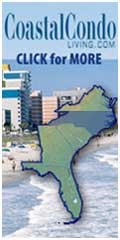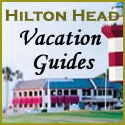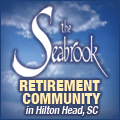A History Of Sea Pines
THE STORY OF SEA PINES HAS been told many times ... and then told some more. No matter who is telling it, or embellishing upon it, its central theme is always one of a man, Charles Fraser, who wasn't afraid to share his ideas and dreams for doing something that had never been done before.
As many have attested, some of
his ideas seemed crazy, at least at the
time. And some of his dreams have
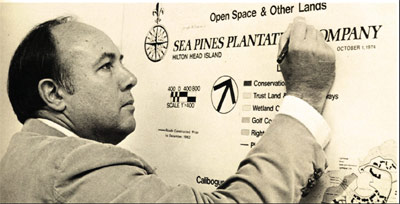 never been realized - yet. However, the
fact that, a half century later,what had
never before been done is still around- and thriving -- is a testimony in itself.
The 50th Anniversary of Sea Pines
is also telling in that it is a story of how
one man's vision for a world-class resort,
coupled with a strong sense of
integrity to preserve the environment,
has withstood the test of time.
never been realized - yet. However, the
fact that, a half century later,what had
never before been done is still around- and thriving -- is a testimony in itself.
The 50th Anniversary of Sea Pines
is also telling in that it is a story of how
one man's vision for a world-class resort,
coupled with a strong sense of
integrity to preserve the environment,
has withstood the test of time.
It is also a story and lesson that money is not everything. When Charles E. Fraser and his brother, Joseph B. Fraser Jr., surveyed the land for timbering purposes, Charles Fraser saw green but not just the monetary kind. If Fraser and his vision for Sea Pines had been all about making money, then the Sea Pines we know today would have a very different look and feel.
Reflecting on Sea Pines' 50th anniversary, Joe Fraser said, "It's rewarding to see how far Sea Pines has come and the fact that so many developers have modeled their communities after it. I think Sea Pines has far exceeded any of our expectations." Joe Fraser believed his brother established a "pattern which other developers followed both here and around the world."
While Charles was known for his ideas, Joe was known as the behind-the-scenes and getit- done guy, helping turn the visions of his younger brother into reality.
"In any company, you have
a top guy with ideas and others
to implement them," said Fraser,
who was  primarily in charge of
design and construction. "I fired
the boiler while my brother made
the speeches. I was just one of the
many team players."
primarily in charge of
design and construction. "I fired
the boiler while my brother made
the speeches. I was just one of the
many team players."
In the early 1950s, Hilton Head Island didn't have electricity, phone service, gas stations or convenience stores. Only one paved road existed, and that was on the north end of the island. At the time, the Lowcountry area of South Carolina was one of the poorest in the state.
Nevertheless, Fraser, a graduate of Yale Law School (he practiced law briefly in Augusta, Georgia) saw potential in the dense forest leading to the Atlantic Ocean. The Fraser family, from Hinesville, Ga., along with the Hack Family, owned the land. The Frasers were in the timber business and were quite successful at it.
It took some prodding before Charles could convince his father, Gen. Joseph B. Fraser, to sell him the land to cut down a few trees - rather than completely level the area- and turn it into a resort/ retirement area. But as Joe Fraser has said, their parents were supportive of whatever they wanted to do. Initially, North Forest Beach,South Forest Beach, Point Comfort and what is now Wexford and Shipyard plantations were all part of the 5,250 acres that comprised Sea Pines, which today stands at 4,450 acres.
The Fraser and Hack families had owned the land, and, when differences on how to develop it arose, the families decided to divvy it up, with the Frasers getting the southern-most portion. Th e price: $800 an acre, a pretty penny at the time.
To convert the swampy, mosquito- infested area of the island required much forethought, something Fraser was well known for. Although there have been subsequent edited and added-to master plans for Sea Pines, Fraser's intent was to do it right and do it right the first time.
His concept was a planned unit
development with strict land-use and
land-preservation covenants. Part
of his research prior to development
also involved air conditioning and a
mosquito control program, two innovations
that radically improved yearround
living.
Based on principles he had
learned at law school, particularly
under the direction of Myres S. Mc-
Dougal,  Fraser and others crafted a
master plan for the resort, incorporating
the use of private-deed covenants
to implement comprehensive
land-use development.
Fraser and others crafted a
master plan for the resort, incorporating
the use of private-deed covenants
to implement comprehensive
land-use development.
It was in 1956, under the Fraser Land Holding Company, that a master plan for Sea Pines came about, followed by the construction of the resort's roads and other infrastructure.
Sea Pines Company didn't start
out as such. It has had many names
over the course of the years, including
Fraser Land Holding Company and
Sea Pines Plantation Company. In the
1970s, "plantation" was dropped from
the name because of its negative connotations
associated with slavery. Today
three companies operate within the
flagship -- Sea Pines Resort, Sea Pines
Real Estate (which also encompasses
residential and commercial properties
outside of Sea Pines) and Community Services Associates.
Fragile and faded development plans still exist with architects' names at the bottom including Sasaki, Walker& Associates in 1956, John Wade in 1962, Corkern & Wiggins Architects in 1964, and George Cobb, who designed the fi rst golf course (Ocean Golf Course) in 1961.
On June 20, 1957, the Sea Pines Plantation Company was incorporated. Charles, who was 28 years old then, became president and Joseph became senior vice president. Their father served as chairman of the board.
Ocean-front lots started at $5,300
but quickly jumped to $7,500 as the
development took shape. Charles built
himself a house on the second row of
Green Heron Road and, by 1960, was
using it as both an example of his idea
of what a Sea Pines house and landscape
should look like and as a place to
entertain clients. Some of them were
turned down as buyers if they didn't
meet the high criteria set by Charles
and his executives.
There were three primary builders of the early houses on Hilton Head - Robert Graves, Bobby Woods and Faris Highsmith. Initially, Fraser, who wasn't a golfer himself, thought it would be difficult to sell any inland homes, but an innovative T-road design, along with the idea of building homes along golf courses, helped sales along.
Fraser wanted to make sure the
community and environment would
withstand the years and came up with
a 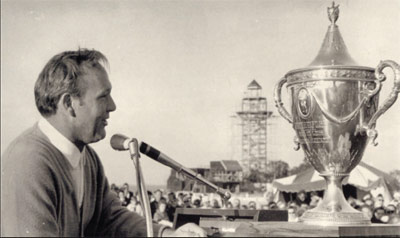 rock-solid set of covenants that are
attached to each private property,
dedicated open space (common areas),
rock-solid set of covenants that are
attached to each private property,
dedicated open space (common areas),
commercial property and forest
preserve. Fraser wanted to ensure
that these covenants could not be
breached.
One of the "clicker" clauses included in the covenants stated that when Sea Pines reached a certain percentage of build-out (which occurred in the mid-70s), the property owners through an association would take over the common elements of the community, including landscaping, forests, roads, easements and waterways. Each owner would be assessed an annual fee to generate funding to manage these elements.
Today, those fees add up to nearly $7 million a year for the upkeep and maintenance of common elements. The association is run by an elected board of directors who serve two- or three-year terms and is comprised of commercial and residential representatives.
In creating a community and all that it entails, Fraser also saw to it that educational facilities and churches would locate at Sea Pines by donating large sums to such entities, many of which are now located on prime property along Pope Avenue and South Forest Beach Drive.
The first private school on the island,
which was underwritten by Fraser
and Sea Pines, was located where the
Holiday Inn near Coligny Circle now
stands. The first Montessori school was
established by his wife, Mary Wyman
Stone Fraser.
Recreation for all ages was to be offered - walking, biking, tennis, golf, playgrounds and swings - a full family package. "Th ere literally was nothing here," said Mary Fraser. "We celebrated when a grocery store came here, a doctor, a laundry service.
"There was a man
who came from Orangeburg
once a week
to deliver milk and
eggs," she added. "He
never knocked or
spoke for that matter.
He'd just come in and
rearrange my refrigerator.
But then, we never
used to lock our doors
back in the early days."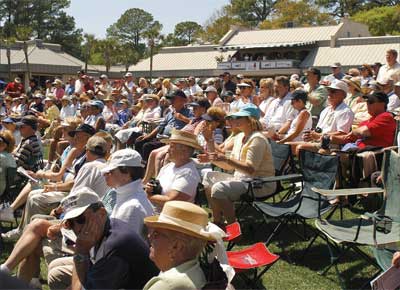
Mary Fraser is credited with making Sea Pines "family friendly." Although she never drew a paycheck after she and Charles were married, she played an instrumental, behind-the scenes role in the success of Sea Pines.
For instance, when Mary heard about an innovative playground located in the heart of Harlem in New York City, she went there (without Charles' knowledge) and shot roll after roll of film. She then modeled the original playground in Harbour Town after that playground, designing it so each piece of equipment worked a different muscle group.
At one point, Mary pushed for mopeds so the children could "buzz around the community." They have since been outlawed within Sea Pines.
Charles Fraser wanted to bring in professional sports, which at the time were just starting to resemble what they are today. He was convinced a Professional Golfers Associationevent was just what the island and Sea Pines needed. Again, his foresight didn't fail him. Since that first Heritage Classic Golf Tournament in 1969, attendance has grown to more than 100,000. In addition, Sea Pines hosted the Family Circle Tennis Cup tournament for several years.
Today there are three golf courses in Sea Pines - Ocean Golf Course , Sea Marsh and Harbour Town Golf Links, which was fi nished in 1969- just in time for the first Heritage golf tournament. As the story goes, sand was still being poured in bunkers as golfers were teeing off for the first round.
The Harbour Town Lighthouse
("Fraser's Folly") was still under construction
at the time of the first tournament.
But Fraser believed the tournament
and the lighthouse were the"hooks" that he was looking for - the
things that would make Sea Pines
stand out and be recognized. Today
the lighthouse is one of the most photographed
lighthouses in the country
and one of the most recognized corporate
logos in the world.
In the early 1960s, the first condominiums in Sea Pines were built, most of them clustered along Lighthouse Road. With them, the nature of Sea Pines changed. It no longer was just a private residential community but was quickly becoming a resort destination catering to vacationers. Visitors became buyers, and, before long, Sea Pines was running out of new property for sale.
In the 1970s, Sea Pines bought the northeast end of the island for more than $8 million, which quickly sold and became its own village, Hilton Head Plantation. For nearly two decades, Sea Pines enjoyed successful growth. Between 1968 and 1974, employment at Sea Pines Company increased tenfold. Charles surrounded himself with smart people, and, in the early 1970s, he was reported to have recruited more Harvard MBAs than any other fi rm in America. Getting their feet wet at Sea Pines, many of them went on to develop other world-class resorts themselves.
Feeling that Sea Pines was close to
completion, Charles tried to develop
3,000 acres on Cumberland Island,
Georgia, and all of Bald Head Island,
North Carolina. In both cases, his efforts
were thwarted. In addition, Fraser
invested in Puerto Rico's Palmas
del Mar in 1970, which incurred "intractable
problems" - a combination
of the ailing economy and a culture
clash.
In 1974, with the national economy plummeting and interest rates soaring, the resort's second home market suffered. Between 1980 and 1986, Sea Pines and Hilton Head Plantation changed ownership three times. In 1982, Vacation Resorts, owned by Heizer Corp., paid $10 million for the company. Then Bobby Ginn came along with a slew of deal-making concepts to get the company back on track, none of which panned out. Ginn sold to Roylat Holding Corp, with financing from Philip Schwab, who sent in a new management team.
Fraser sold his stake in Sea Pines in 1983. However, he continued to live on the island, serving on the island' council and boards of other developments. Sea Pines and Fraser's visions have served as the template for the planning of Hilton Head Island, as well as other resort communities, including Amelia and Kiawah islands."Through all of the ups and downs in the industry, Charles persevered," Mary said. "He changed so many lives for the better."
In 1986, Sea Pines declared involuntary bankruptcy. However, it emerged just one year later, better and stronger for the most part. John Curry was appointed as trustee and John West as legal advisor. Company assets were sold off and Sea Pines residents formed Sea Pines Associates, a publicly held company, to own the existing resort properties. Community Services Associates, which had been formed to own all common property, including roads and open space, was officially dedicated out of the bankruptcy as a viable, independent entity.
As the company struggled, the future of the Heritage golf tournament also was uncertain. In 1987, however, the tournament and golf course were saved with the creation of the Heritage Classic Foundation. The same year Sea Pines Associates brought together all of the resort community except for South Beach.
The formation of Sea Pines Associates was the important next step in taking Sea Pines where it needed to go, convincing the community and fi nancial world that it would be able to stand on its feet once again. It also made improvements to Harbour Town and other recreational facilities.
Only three years ago, Sea Pines Associates board members, after accomplishing what they set out to do, announced their intent to sell the resort, but only a person or entity who would be a good steward and who would carry on Fraser's original intent for the community. They also insisted that potential buyers be of sound financial standing.
During Sea Pines' publicly held years, several people purchased large blocks of stock, including Bill Goodwin of The Riverstone Group. In March 2005, the Riverstone Group purchased Sea Pines. In one of the few times in its history, Sea Pines is now in good financial standing. Its future looks bright. For Charles and Mary Fraser, Sea Pines was "really a love effort. We lived it," Mary said. She recalls that shortly before his death, the couple was driving through Sea Pines one afternoon. "He looked at me and said, 'You know, the road system in here really works.'"



